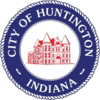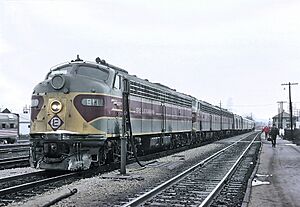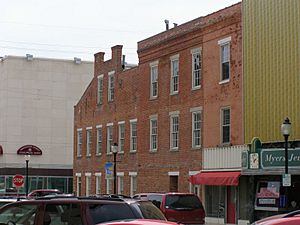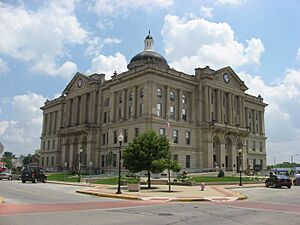Huntington, Indiana facts for kids
Quick facts for kids
Huntington, Indiana
|
|||
|---|---|---|---|

Aerial view of Huntington
|
|||
|
|||
| Nickname(s):
"The Lime City"
|
|||
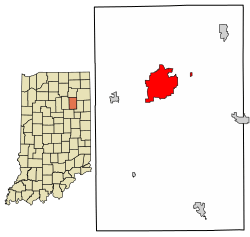
Location of Huntington in Huntington County, Indiana
|
|||
| Country | United States | ||
| State | Indiana | ||
| County | Huntington | ||
| Government | |||
| • Type | Mayor-council government | ||
| Area | |||
| • Total | 9.45 sq mi (24.47 km2) | ||
| • Land | 9.31 sq mi (24.12 km2) | ||
| • Water | 0.14 sq mi (0.35 km2) | ||
| Elevation | 791 ft (241 m) | ||
| Population
(2020)
|
|||
| • Total | 17,022 | ||
| • Density | 1,827.96/sq mi (705.81/km2) | ||
| Time zone | UTC−5 (EST) | ||
| • Summer (DST) | UTC−4 (EDT) | ||
| ZIP Code |
46750
|
||
| Area code(s) | 260 | ||
| FIPS code | 18-35302 | ||
| GNIS feature ID | 2394452 | ||
| Website | www.huntington.in.us/city | ||
Huntington, often called the "Lime City," is the biggest city in Huntington County, Indiana, USA. It's also the county seat, which means it's where the county's main government offices are. Huntington is part of the larger Fort Wayne, Indiana area. In 2020, about 17,022 people lived there.
Contents
History of Huntington
How Huntington Got Its Name
Huntington was named by Captain Elias Murray. He was a member of the state legislature. The city's name comes from Samuel Huntington. He was a judge, politician, and a patriot during the American Revolution.
Samuel Huntington was also the third governor of Connecticut. He was the seventh president of the Continental Congress. As a delegate, he helped vote for and sign the Declaration of Independence. He also signed the Articles of Confederation.
Early Days of the City
Huntington County officially started on December 2, 1834. The city of Huntington was first settled by pioneers. Captain Elias Murray was one of the most important settlers. By 1849, Huntington had 150 houses and about 700 people living there.
Books About Huntington's Past
Some books have been written about Huntington County's history. The first was History of Huntington County, Indiana. It was published by Brant & Fuller.
Other books include History of Huntington County, IN by Frank Sumner Bash (1914). This book describes the city's progress and its people. Another book is Huntington County, IN: Histories and Families (1993). This book was put together by the Huntington County Historical Society. It shares the family histories that have shaped Huntington for over 175 years.
The Wabash and Erie Canal
The Wabash and Erie Canal was built through Huntington County in 1834. This canal brought a big economic boost to the area. The Wabash River already flowed through Huntington. The new canal helped the city grow even faster. It brought more people and more businesses.
Geography and Climate
Where Huntington is Located
Huntington is located on the Wabash River. The city covers about 9.45 square miles (24.47 square kilometers). Most of this area is land. Only a small part is water.
Huntington's Weather
| Climate data for Huntington, Indiana (1991–2020 normals, extremes 1893–present) | |||||||||||||
|---|---|---|---|---|---|---|---|---|---|---|---|---|---|
| Month | Jan | Feb | Mar | Apr | May | Jun | Jul | Aug | Sep | Oct | Nov | Dec | Year |
| Record high °F (°C) | 66 (19) |
75 (24) |
86 (30) |
91 (33) |
97 (36) |
106 (41) |
110 (43) |
105 (41) |
103 (39) |
94 (34) |
81 (27) |
71 (22) |
110 (43) |
| Mean maximum °F (°C) | 56.0 (13.3) |
59.4 (15.2) |
70.6 (21.4) |
80.9 (27.2) |
88.6 (31.4) |
93.0 (33.9) |
93.6 (34.2) |
92.5 (33.6) |
90.4 (32.4) |
82.9 (28.3) |
69.1 (20.6) |
58.6 (14.8) |
94.5 (34.7) |
| Mean daily maximum °F (°C) | 33.3 (0.7) |
37.0 (2.8) |
48.0 (8.9) |
61.4 (16.3) |
72.6 (22.6) |
81.1 (27.3) |
84.4 (29.1) |
82.6 (28.1) |
76.8 (24.9) |
64.2 (17.9) |
50.0 (10.0) |
38.2 (3.4) |
60.8 (16.0) |
| Daily mean °F (°C) | 25.2 (−3.8) |
27.9 (−2.3) |
37.4 (3.0) |
49.3 (9.6) |
60.4 (15.8) |
69.7 (20.9) |
73.0 (22.8) |
71.1 (21.7) |
64.2 (17.9) |
52.3 (11.3) |
40.5 (4.7) |
30.4 (−0.9) |
50.1 (10.1) |
| Mean daily minimum °F (°C) | 17.0 (−8.3) |
18.7 (−7.4) |
26.9 (−2.8) |
37.1 (2.8) |
48.2 (9.0) |
58.3 (14.6) |
61.7 (16.5) |
59.6 (15.3) |
51.6 (10.9) |
40.3 (4.6) |
31.0 (−0.6) |
22.7 (−5.2) |
39.4 (4.1) |
| Mean minimum °F (°C) | −4.2 (−20.1) |
0.0 (−17.8) |
10.2 (−12.1) |
22.8 (−5.1) |
33.1 (0.6) |
44.0 (6.7) |
50.9 (10.5) |
49.2 (9.6) |
38.3 (3.5) |
27.1 (−2.7) |
16.9 (−8.4) |
4.5 (−15.3) |
−7.9 (−22.2) |
| Record low °F (°C) | −28 (−33) |
−18 (−28) |
−11 (−24) |
6 (−14) |
24 (−4) |
34 (1) |
42 (6) |
35 (2) |
26 (−3) |
15 (−9) |
−5 (−21) |
−24 (−31) |
−28 (−33) |
| Average precipitation inches (mm) | 2.49 (63) |
2.18 (55) |
2.66 (68) |
3.95 (100) |
4.71 (120) |
4.61 (117) |
4.48 (114) |
3.66 (93) |
3.25 (83) |
3.00 (76) |
3.25 (83) |
2.38 (60) |
40.62 (1,032) |
| Average snowfall inches (cm) | 9.9 (25) |
6.7 (17) |
2.8 (7.1) |
0.4 (1.0) |
0.0 (0.0) |
0.0 (0.0) |
0.0 (0.0) |
0.0 (0.0) |
0.0 (0.0) |
0.0 (0.0) |
1.0 (2.5) |
5.1 (13) |
25.9 (66) |
| Average precipitation days (≥ 0.01 in) | 11.1 | 8.3 | 9.7 | 12.0 | 12.2 | 11.8 | 10.3 | 9.0 | 8.3 | 9.8 | 10.1 | 9.8 | 122.4 |
| Average snowy days (≥ 0.1 in) | 5.3 | 4.0 | 1.8 | 0.3 | 0.0 | 0.0 | 0.0 | 0.0 | 0.0 | 0.0 | 0.7 | 3.4 | 15.5 |
| Source: NOAA | |||||||||||||
Huntington has a varied climate. Summers are warm, and winters are cold. The city gets a good amount of rain and some snow each year.
People of Huntington
Population Over Time
| Historical population | |||
|---|---|---|---|
| Census | Pop. | %± | |
| 1850 | 594 | — | |
| 1860 | 1,664 | 180.1% | |
| 1870 | 2,925 | 75.8% | |
| 1880 | 3,863 | 32.1% | |
| 1890 | 7,328 | 89.7% | |
| 1900 | 9,491 | 29.5% | |
| 1910 | 10,272 | 8.2% | |
| 1920 | 14,000 | 36.3% | |
| 1930 | 13,420 | −4.1% | |
| 1940 | 13,903 | 3.6% | |
| 1950 | 15,079 | 8.5% | |
| 1960 | 16,185 | 7.3% | |
| 1970 | 16,217 | 0.2% | |
| 1980 | 16,202 | −0.1% | |
| 1990 | 16,389 | 1.2% | |
| 2000 | 17,450 | 6.5% | |
| 2010 | 17,391 | −0.3% | |
| 2020 | 17,022 | −2.1% | |
| U.S. Decennial Census | |||
Huntington's population has changed over the years. In 2010, there were 17,391 people living in the city. By 2020, the population was 17,022.
Who Lives in Huntington?
In 2010, there were 17,391 people in Huntington. Most residents were White (96.4%). Other groups included African American, Native American, and Asian people. About 2.4% of the population was Hispanic or Latino.
There were 6,566 households in the city. About 34% of these households had children under 18. The average age of people in Huntington was 33.4 years old.
Schools and Education
The Huntington County Community School Corporation serves Huntington. It also serves all of Huntington County. The main high school is Huntington North High School.
There are two middle schools: Crestview Middle School and Riverview Middle School. The elementary schools include Flint Springs, Horace Mann, Lincoln, Roanoke, and Salamonie. Huntington Catholic School is a private school run by the Roman Catholic Church.
The city also has a public library. It's called the Huntington City-Township Public Library.
Economy and Business
A large Catholic publisher, Our Sunday Visitor, has its main office in Huntington. This company is an important part of the local economy.
Communications
Local Radio Stations
Huntington has several local radio stations:
- WJCI FM 102.9
- WBZQ AM 1300 La Jefa Radio (Spanish)
- WVSH FM 91.9 The Edge (a high school station from Huntington North High School)
- WQHU FM 105.5 FUSE FM (from Huntington University)
Transportation
Huntington Municipal Airport is a small airport. It's used for general aviation and is located southeast of the city.
Several major highways pass through Huntington:
 US 24
US 24 US 224
US 224 SR 5
SR 5 SR 9
SR 9
Famous People from Huntington
Sports Stars
- Gary Dilley: An Olympic silver medalist in swimming.
- Dusty Fahrnow: An Indy Car driver.
- Josh Hart: A professional NHRA race car driver.
- Lauren Johnson: A professional runner.
- Harry Mehre: A football player.
- E. J. Tackett: A professional bowler.
- Addison Wiley: An American middle-distance runner.
Other Notable People
- Dan Butler: An actor.
- Elizebeth (Smith) Friedman (1892–1980): An author and a pioneer in the field of cryptology (code-breaking).
- Jennifer Lancaster: An author.
- Mick Mars: The guitarist for the band Mötley Crüe.
- John F. Noll: An archbishop and newspaper founder.
- Carrie M. Shoaff (1849–1939): An artist, author, potter, playwright, and correspondent.
- Richard Leroy Walters: A philanthropist known for helping the homeless.
Places to Visit
Huntington has many interesting places to see:
- Church of the United Brethren in Christ National Headquarters
- David Alonzo and Elizabeth Purviance House
- Drover Town Historic District
- Forks of the Wabash
- Hawley Heights Historic District
- Hotel LaFontaine
- Huntington County Historical Museum
- Huntington Courthouse Square Historic District
- Huntington University Arboretum and Botanical Garden
- Huntington University
- J. Edward Roush Lake
- Merillat Centre for the Arts
- Moore/Carlew Building
- North Jefferson Street Historic District
- Old Plat Historic District
- Our Sunday Visitor
- Quayle Vice Presidential Learning Center
- Samuel Purviance House
- St. Peter's First Community Church
- Sheets Wildlife Museum and Learning Center
- Sunken Gardens
- Taylor-Zent House
- The Indiana Room Genealogy Center
- Victory Noll-St. Felix Friary Historic District
- William Street School
See also
 In Spanish: Huntington (Indiana) para niños
In Spanish: Huntington (Indiana) para niños



